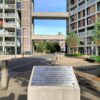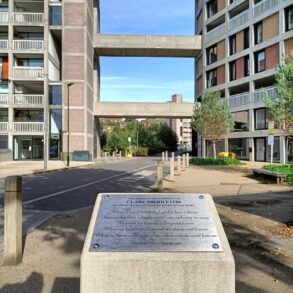Content warning: This story mentions suicide and includes descriptions of violence and drug use.
Sitting at the intersection of Poland Avenue and Dauphine Street, a chain-linked barbed wire fence straddles five blocks of residential homes before turning and encircling 25 acres of a concrete canvas of graffiti; three six-story buildings imposing their will over the Bywater neighborhood.
Originally an Army supply depot during WWI, the towering complex served as a Port of Embarkation during WWII before it was transferred to the Navy’s possession in 1966. The Naval Support Activity (NSA) base was subsequently named after Louisiana’s longest-serving U.S. Congressman, F. Edward Herbert.
Peggy Lou fondly remembers some of the 4,600 Navy sailors and Marines employed at the F. Edward Herbert complex. For years, she watched soldiers run by her home in the morning, listening for their testosterone-fueled chants.
“They would accumulate with their tank tops and shorts,” she said. The rest of the Bywater women would also watch, ready to hand out a cold drink to any Marine who needed it.
A part-time DJ for WWOZ, Lou is exceptionally hip for a 76-year-old. Like many of her neighbors, she moved to the area after Hurricane Katrina due to its minimal flooding. As wealthy homebuyers flocked from the French Quarter and developers began renovating many of its historic buildings, the average household income went from $45,500 adjusted for inflation in 2000, to $77,315 two decades later.
But gentrification has had little effect on the base, which closed in 2011. Thirteen years later, it’s the largest blighted property in New Orleans, a derelict horror to many, filled with meth labs and asbestos. Nearby residents have seen possessions like bikes and catalytic converters stolen, and their property values plummet.
Now, after more than a decade of uncertainty and stagnation, new sources of funding have neighbors and developers feeling cautiously optimistic.

Aidan McCahill
/
WRKF
On a sticky July afternoon, I stood outside Bacchanal Wine bar, gazing intently at the graffiti spread across the buildings: a baby with a cigar in his mouth, drinking Jack Daniels and flipping the bird, among other drawings too lewd to mention.
As I began tallying the offensive graffiti before my eyes, the man I was waiting for arrived. Unlike most of his neighbors, Az, 41, has a symbiotic relationship with the site. He’s a graffiti artist, responsible for the more uplifting “art brut” found inside the vacant lot.
His jeans were covered with paint. He wore a black T-shirt, and wielded spray paint in one hand, a jug of iced tea in the other. I shook his hand and studied the multiple tattoos and piercings adorning his body. He flashed an infectious grin, and I followed him inside.
“I like to go in places tripping and just start painting somewhere,” he said, showing me his first mural, a multicolored depiction of a boy in a tunnel with a soft yellow light at the end.
Psychedelics help him establish relationships with the objects he paints on.
“If you get lost in a painting too much then there’s this weird amount of detail,” he said. So he’ll return later, sobered up, and finish what he started.
Look on my Works, ye Mighty, and despair!
Nothing beside remains. Round the decay
Of that colossal Wreck, boundless and bare
The lone and level sands stretch far away.”
Excerpt from Ozymandias by Percey Shelley, (Az’s favorite poem)
Az used to be a writer, YouTuber, and tech startup employee. He found his passion during COVID-19 when he picked up a brush out of boredom, and not long after started working at an art gallery in New Orleans. When the gallery shut down, he turned to a different kind of painting – the spray kind. He’s drawn to abandoned properties like NSA because, for the most part, he doesn’t have to worry about being chased. After years of using NSA as his studio, he’s formed friendly relationships with some of the roughly two dozen people living inside.
We continued walking through the first building and ascended a flight of stairs. The three buildings, each a staggering 500,000 square feet, are connected by bridges. The building’s foundation and its underpinning remain intact, and the floors and pillars that separate them feel sturdy for the most part. But the windows were gone. Most of the metal had been scraped with the ceiling joists and tiles strewn about the hallways or jutting down like vines. While I attempted to mimic Az’s adroit ducking and bobbing, visibility began to worsen and the place quickly turned into a labyrinth-like Call of Duty zombies map. I asked my guide if he ever got scared.
Az laughed, and said he’s only ever scared himself. “I’m biased because I’m an atheist,” he said. “But this place isn’t haunted at all.”
After the building closed in 2011, it wasn’t long before it began worrying nearby residents. Firefighters were called to the site 23 times between 2018 and 2021 to extinguish trash fires. Multiple gunfights ensued in the building, at one point prompting NOPD to swarm the base and put the surrounding neighborhood under lockdown.
In 2020, the body of a 25-year-old waitress from Slidell was found at the site. She had been shot to death. Then came the growing city of tents next to the base.
“There were chop shops in there… drug dealing…they found bodies…it was crazy,” said John Guarnieri, president of the Bywater Neighborhood Association.

Aidan McCahill
/
WRKF
By 2022, NSA was the city’s skid row, and Bywater residents were fed up. That July, SWAT teams descended on the complex, and took around 40 to 50 squatters out of the building.
“There were maybe about 100 homeless people living there,” said longtime Bywater resident Brian Luckett.
Now that it’s no longer full of “murderers, thieves, and rapists,” he just views it as an “enormous eyesore.”
However, neighbors still have concerns and rumors persist.
I asked a woman inside if there was a “social hierarchy” in the building, envisioning a criminal den with a drug dealer boss living on the top floor. She laughed in my face.
“It’s a lot of normal people down on their luck,” said Jorden, a man in his mid-thirties who lives at the site. Most of the tenants, he said, were “ordinary people experiencing extraordinary circumstances.”
Once we got up a few flights of stairs, we passed a shirtless man drenched in sweat. He appeared distressed but recognized Az and they exchanged cordial greetings before we kept going.
“He’s one example,” Az said.
According to Az, the man had mild autism, which by some estimates affects 12 times more homeless people than the general population. Az also has autism and said he learned social skills like making eye contact through YouTube. He told me he’s the kind of guy who seems to have the right intentions but keeps slipping through the cracks.
I met another man named Austin. He had a headlamp strapped to his forehead. After being released from prison at 29, Austin spent time on the streets before he found the NSA in 2022. He’s addicted to meth, which he buys with about 25% of the money he gets from scrapping. For Austin, the drug “kills his emotions,” helping him deal with reality. He considers himself Christian, and called the abandoned complex “spiritual”, but added that “the environment can change very quickly.” Austin has kids in Florida and longs to see them.

Aidan McCahill
/
WRKF
Evidence suggests about 25 to 50% of homeless Americans suffer from some form of addiction. “It’s not a criminal thing, it’s a people hurting people thing,” Az said. “People that are not able to connect the way they need to.”
The NSA feels disconnected, like someone messed with the circuit breaker and unleashed a cloud of disjointed energy.
“Some of the people here will tell you that I’m a problem individual,” said Chris, a middle-aged man with a New Orleans accent so thick it could be mistaken for Jersey. “Other people will tell you that I’m a good dude. “
“It’s like a prison,” he said, describing the complex. “It has its own set of rules.”
Rule #1: Keep to yourself. Then I asked about murders in the building, before the 2022 raids.
“No one gets killed here,” he said, “It’s not like that.”
Occasional screams could be heard from inside the building as the sole security guard looked around hesitantly.
“Most people here have some sort of mental illness,” Chris added.
At one point in his life, Chris ran a landscaping business while moonlighting as a security guard in the French Quarter.
“I was married, had a house on the West Bank, and four kids,” he recalled.
One day, Chris said he came home to discover his wife’s unexpected infidelity. He laid hands on her and spent several years in prison as a result.
“I lost everything I own in that whole exchange,” he said.
I told him once one hits rock bottom, the only way is up.
“There are levels to the bottom,” he replied.
Right now, Chris says his life has been pretty stagnant, but he won’t reach out to homeless services because he doesn’t like the strings attached.
“I don’t like rules,” he said.
Inside the building, a jerry-rigged generator hummed calmly, its monotonous sound broken only by the trickle of water from someone harnessing the building’s pipes to take a shower. Outside there was a constant din; someone dragging metal, hucking trash from a balcony, or playing the drums with plywood to pass the time. On windy days, sheet metal rattles from the top of a warehouse tunnel next to the buildings. The tunnel leads to a shipyard, where the MV Cape Knox sits docked on the Mississippi River. The 3,500-ton Navy reserve ship can mobilize within five days of notice.
Back inside, Az asked me if I’d ever been homeless.
“You won’t need more than two weeks of doing it to empathize,” he said. “It’s not [expletive] easy, not knowing what you’re waking up to…if you’ll have the things you did the day before.”
A place like NSA he said, where one can barricade themselves into some semblance of safety, can go a long way.
“You’re constantly in survival mode, fight or flight…and all of a sudden you get a place to stay? You sleep for three days straight.”
I told Az about Chris refusing to access homeless services.
“You want a free place? You have to stay somewhere on the neutral ground or under the overpasses,” said Az.

Aidan McCahill
/
WRKF
Instead of forcing themselves to become visibly homeless, begging in plain sight to be considered for a shelter, some chose the alternative–squatting.
Joe Heeren-Mueller, who works for Unity New Orleans, a nonprofit that provides rapid rehousing, estimates about two-thirds of the city’s homeless population live in shelters. The rest would rather stay invisible.
“You could house everybody who’s living in an encampment of 10 or more, and it would only scratch the service of everyone who is unsheltered in the city,” he said.
There are plenty of reasons someone wouldn’t want to stay in a shelter, he said. “[But] I’ve worked with 10–maybe 20,000 unhoused people in my career. If you can offer them safe, secure affordable housing, I haven’t known anyone not to take it if they understand and appreciate what’s being offered.”
Az led me deeper into the maze. We passed a woman with her dog before entering an office, the cubicles peppered with drywall and shattered glass. Then we entered a movie theater. The projectors were lying on their sides.
“This is what the zombie apocalypse looks like,” Az said, “It’s [expletive] amazing!”
The eyesore eerie vibe has made it a hotspot for TV and film; “Project Power,” starring Jamie Foxx and Joseph Gordon Levitt, and the post-apocalyptic Twisted Metal with Anthony Mackie to name a few.
Darius Frederick worked at the NSA during its twilight, arriving in the Bywater neighborhood as a Lance Corporal for the Marines in October 2010.
Four months before Hurricane Katrina, the base was slated for closure as part of the Defense Department’s Base Closure and Realignment Commission (BRAC). As the Pentagon saw it, the $142 million annual payroll for a base with no combat training would be money better spent on R&D into new weaponry, though it took several more years to close the place down for good.
Frederick remembers entire rooms and offices sitting unoccupied as the building slowly transitioned into its current state.
“There were these floors where there would be all this furniture in the hallway, just random desks, and things,” he said.
He remembers the vacant floors as places where people went for a little extra privacy. “You could take a s** down there, no one would bother you.”
It was also “well known” that Marines used the floors and its couches for extracurricular activities. “Especially the female Marines,” he added. “They had a reputation.”
In 2013, the Navy handed the base to the City of New Orleans under an agreement the site would be redeveloped into a mixed-use facility. The project was supposed to be a joint venture with the commercial real estate group EMDRC Partners LLC, owned by the late Joe Jaeger, and was contingent on receiving a $40 million FEMA grant to kickstart the redevelopment.
But when a 99-year lease was signed by EMDRC partners in 2016, the FEMA grant money had dried up. It was reallocated the year before to the City’s Sewerage and Water Board by its director Cedric Grant. Grant was forced to resign for unrelated issues in 2017, and EMDRC largely halted communications with the new Cantrell administration.
“They had the opportunity to get grant funding,” said Guarnieri referring to the city. “They missed it.”
Over the years, plans for affordable housing, film studios, and even a port for Disney cruise lines had been seriously discussed, but the funding secured was never sufficient to begin construction. The projects, some estimated to have a $300 million impact on the region, proved more ephemeral than material.
The movie theater started to feel like a sauna and we kept moving. We reached a place Az called the “Nightmare Room,” an accurate microcosm for the building. The room is pitch black and filled with depictions of sleep paralysis demons, hooded figures, and one particularly unsettling pair of dead black eyes, peering curiously from the bottom of a dresser. Looking at the graffiti tags, it was clear Az was responsible for the haunting murals. They were therapy for him. By giving life to his recurring nightmares, the murals become a sort of cathartic, psychoanalytical release, uncorking a bottle of pent-up anxieties.
“Art’s job is to communicate the incommunicable,” Az said. “Finding this inexpressible thing and trying to express it.”
I brought up something Peggy Lou had mentioned. She didn’t have much of an issue with the building or the people inside, saying she was happy the building blocked rain and squalls during hurricane season. But she doesn’t like waking up every morning and seeing graffiti outside her window.
“Murals are art,” she said. “Graffiti – the tagging – is ego.”
Az laughed. “We all agree,” he said, but argued the same can be said for what hangs in the Louvre. After all, wasn’t Van Gogh a little egotistic for cutting off his ear after some bad reviews?
At NSA, art is a reflection of ego, with an altered dimension.
“You ever feel so small and insignificant that when you die no one will remember you five years down the line?” Az asked.
In the deserted hallways, people left a part of themselves behind via spray paint: their initials, words of encouragement, a quote that sticks it to the man. It doesn’t matter so long as it lets the world know you exist.
We were nearing the end of the tour when Az insisted on showing me one more mural–a collaboration with a female artist named Nitrous. It was a depiction of Nitrous’s sister, who died by suicide. She is bounded in mid-air by ropes tied to all four limbs, caught in a sort of spiritual limbo. On the edges of the mural, there are three silhouettes representing Nitrous: One manning the ropes controlling her sister, one shooting her, and one cutting her down.
Az posted the mural on Instagram post and wrote:
“We have a complete portrait of that devastating range of contradicting emotions as they swing from one to the next and back around again, dragging Nitrous through the whole mess. It’s my favorite painting in the old Navy Base, and I’m so glad she let me be part of it.”
Peggy Lou, I knew, would approve.
Finally, we made it to the roof and looked down at the industrial canal as it flowed into the Mississippi, watching large barges saunter towards the Gulf. On the horizon was Plaza Tower, another one of Az’s favorite abandoned properties owned by Joe Jaeger. Jaeger, a well-known New Orleans business figure, was notorious for owning several blighted properties across the city. He kept promising residents there would be funding for the redevelopment of NSA up until he passed away in a car crash in June.
“Joe was not really the best at public meetings,” Guarnieri said. The last one, he recalled, was a “total disaster.”
A former high-school educated plumber from the 9th Ward, Jaeger grew his mechanic company into one of the city’s most prominent real estate firms and owned more hotels in the French Quarter than any other businessman in the city. But he also owned the Naval Building, Plaza Tower, Lindy Boggs Medical Center, and Market Street Power plant–all abandoned–and Jaeger developed a reputation that preceded him.
“People want to blame Joe Jaeger for his horrible track record,” said Guarnieri. “But I do think the city bears some of the blame for this. “
Aug. 19 marked the first meeting between developers and residents without Jaeger, and the room in Stallings Community Center was packed with Bywater residents. Jaeger’s former coworkers and developers with a new firm, Brian Gibbs Real Estate, vowed to finish the job he started. At the meeting, developers and city officials presented PowerPoint slides showing renderings of happy shoppers enjoying a strip of future ground-floor retail stores, and retiring to one of the 294 proposed affordable housing units above.
The Louisiana Housing Corporation awarded the developers $20 million for the $166 million “NSA East Bank Apartment Complex project.” The project is expected to receive another $8.5 million from the city, and significant tax credits: $48 million in state low-income housing tax credits and $54 million in state and federal historic tax credits, pending final approval of plans by the National Park Service and Internal Revenue Service.
The money is for “Phase 1”, which would only renovate the first two buildings. About $36 million in financing is still needed.
“It’s a moving target,” said Peter Aamodt, a developer working with Brian Gibbs Real Estate. “I’d tell you something and you’d write it, the next week it wouldn’t be the same.”
Still, developers told residents they were optimistic about closing the funding gap with money from places like Housing and Urban Development and the Housing Authority of New Orleans. If successful, construction crews might break ground on NSA by early 2025.
It seemed hope was finally in the air. After years of unproductive community meetings, phrases like “light at the end of the tunnel” were thrown out with genuine belief.
Naturally, plenty of logistical questions remain, including the future of the third building. Its fate was marked on a poster under Phase 2 with the words “TBD”, constantly referenced by developers as something to be “cocooned” until further notice.
After the meeting, I called Az, wanting an update on the people inside the building. A few weeks before the meeting, NOPD cleared out the encampments again, and it was unclear if they offered any emergency rehousing.
“Every Friday, they’ve been clearing it out,” said Az. “But for the most part, they’ve been letting people back in during the week.”
Az didn’t know what to think. Of course, Bywater residents were entitled to sleep at night without worrying about waking up to gunshots or strangers walking across their lawns. Restaurants like Jack Dempsey’s would be crowded again, filled first by thousands of construction workers, then with new residents and shoppers. At the same time, it would strip the last semblance of stability from the people Az had grown close to.
When I told him that at least some of the rooms would be converted to affordable housing, there was a sigh of relief over the phone. A few apartments were even supposed to go as low as 30 percent of the average median income. Less blight for Bywater residents and more affordable housing? As long as the city kept its promise, it seemed like a win-win. For Az, it was a silver lining to an otherwise confusing mix of emotions.
As for his art being destroyed? That’s just the transient nature of graffiti, he said, and the rest of the material world for that matter.
“I have this fear that I’m gonna die without being remembered for very long,” Az said. “But I also know in 200…1,000 years, it won’t matter anyway.”
This post was originally published on this site be sure to check out more of their content.








